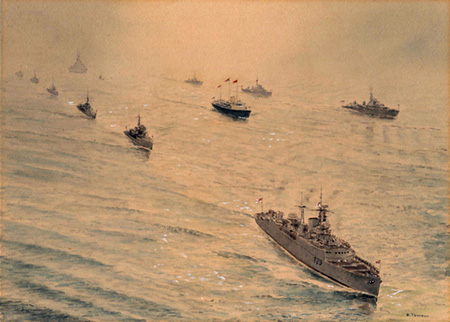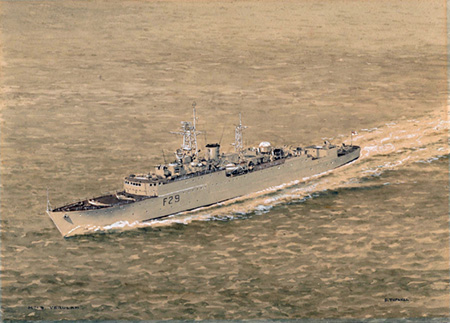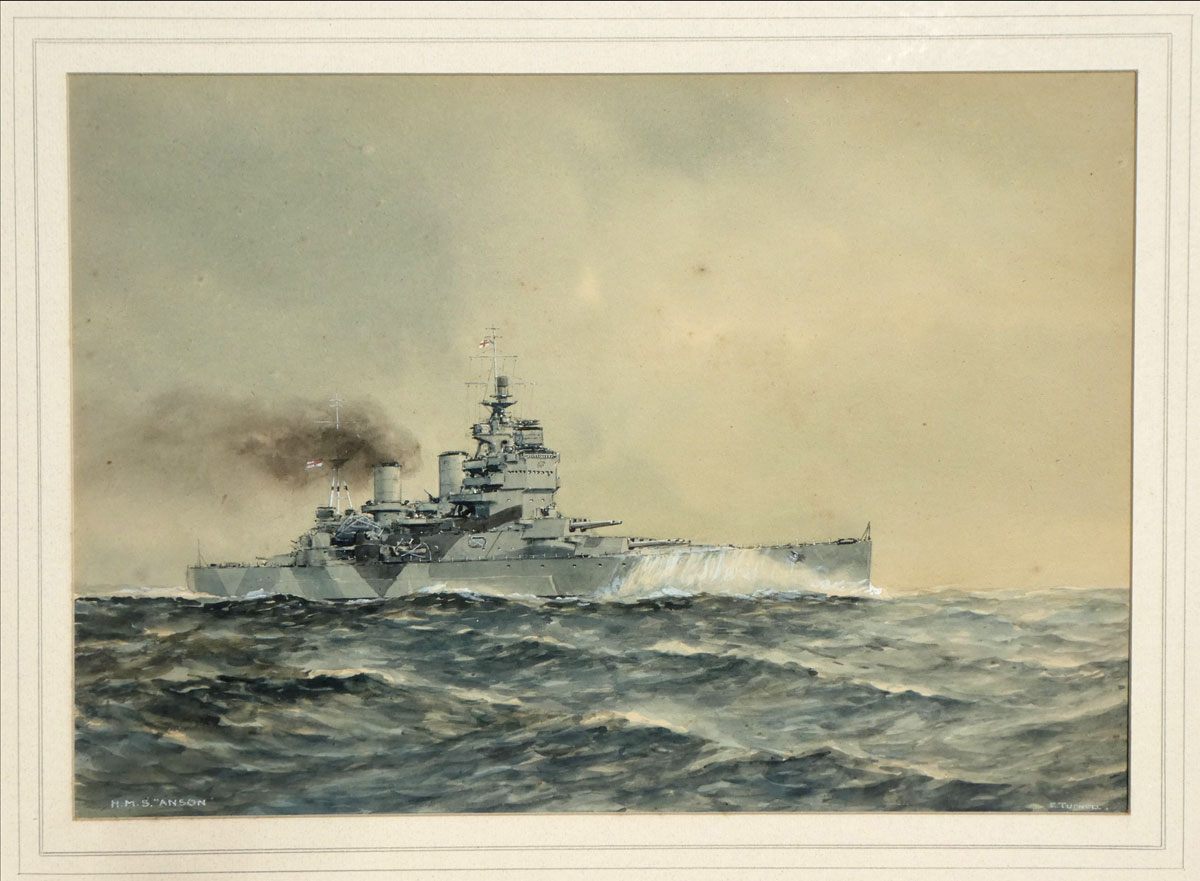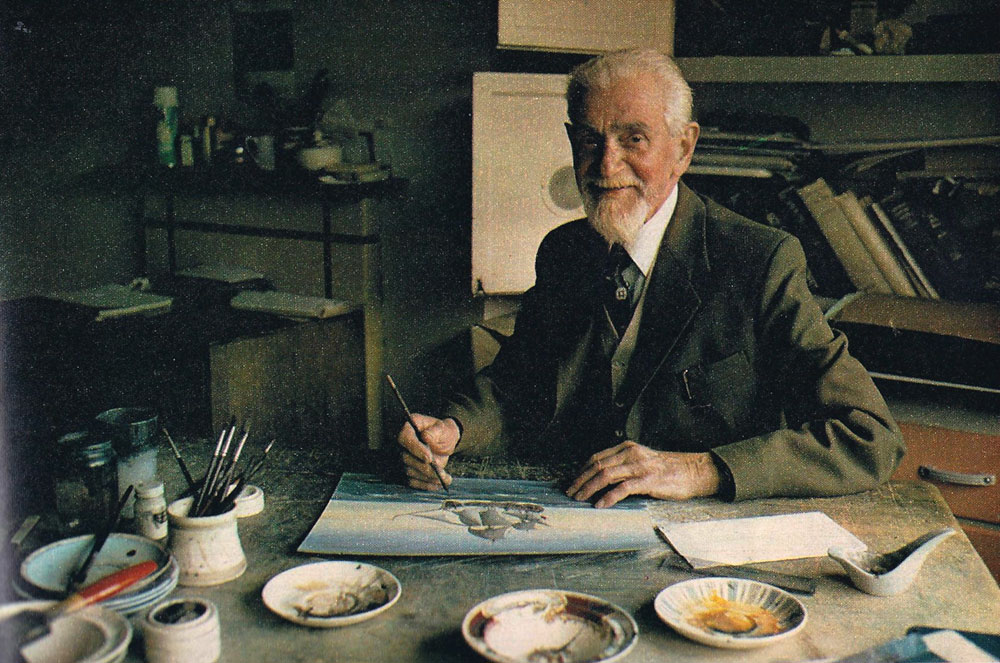






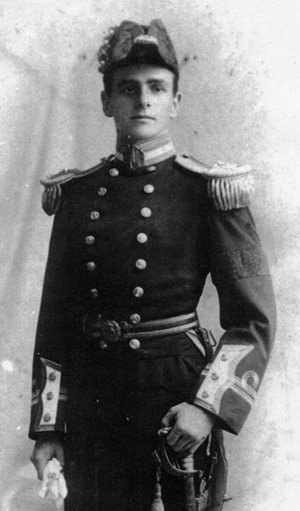
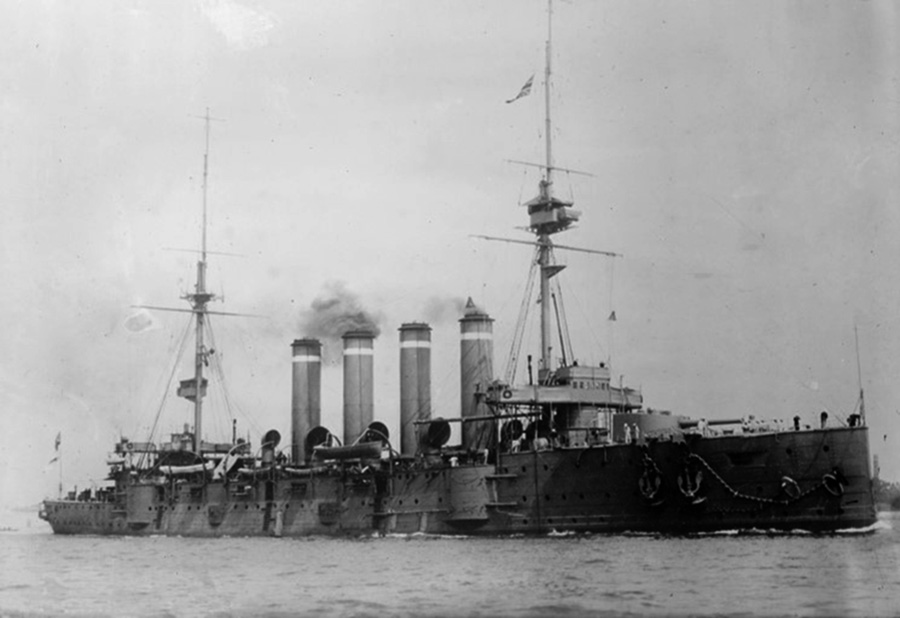
Eric
Tufnell
was born in Bangalore, India, where his father, Major
Robert Hutchison Campbell Tufnell (1852-1908), who fought in the
Afghan wars was stationed. The family were sufficiently important to
have their history recorded in Burke's Genealogical and Heraldic History of the Landed Gentry.
His mother, May Anne
Luard Tufnell (neť Smith), was born in Madras, the youngest daughter of
Judge Alexander Smith. His uncle was Admiral Lionel Grant Tufnell
RN (1857-1930). By
the time of the
1901 Census the family had returned to England and were
living at Lackham House, Spring Grove, in
Isleworth, which was built around 1860 by Eric's grandfather, Thomas
Robert
Tufnell (1822-98), the Chairman of the Royal Mail Line Steam Packet
Company. He
named his new house after the Manor of Lackham on the River Avon
between Chippenham and Laycock, where he was born in 1822. Thomas
Tufnell had retired to fashionable Hove near Brighton leaving Lackham
house empty for the family of his eldest son when he returned from
India. In 1901 his
grandson, twelve
year old Eric Tufnell, was a boarder at Devonshire
House,
Bexhill, in East Sussex. With only one master and thirty three pupils
ranging in age from eight to fifteen it is unlikely that he received a
particularly good education. Eric's father was born in April 1852 at
the North Kent Dockyard, Northfleet, near Gravesend on the Thames
estuary, where many of the Royal Mail Line’s ships were built at
Pitchers Yard in Northfleet.
 Eric's future was settled for him in 1903 when at the age of fifteen he became a cadet at HMS Britannia. This early painting (courtesy of Simon Kesley) signed with the superimposed ET he used at the time, shows HMS Hindustan (left) and HMS Britannia,
the two hulks moored on the River Dart, where cadets were trained
before the building of the Royal Navy College at Dartmouth in 1905.
Eric's future was settled for him in 1903 when at the age of fifteen he became a cadet at HMS Britannia. This early painting (courtesy of Simon Kesley) signed with the superimposed ET he used at the time, shows HMS Hindustan (left) and HMS Britannia,
the two hulks moored on the River Dart, where cadets were trained
before the building of the Royal Navy College at Dartmouth in 1905.
He
"gained 7 1/2 months time on passing out of Britannia" and in September 1904 joined the twin screw battleship, HMS Albion,
shortly after it recommissioned at Wei-Hai-Wei on the China Station. It
may not have been a coincidence that his uncle, Rear-Admiral Lionel
Grant Tufnell RN was also on the China Station. He was appointed
Midshipman on 30 November.
All midshipman were required to keep a logbook but Tufnell's leather bound Naval Log and Journal covering
the years 1904-7 and illustrated with sketches, maps, sectional
drawings of ships, photographs and newspaper cuttings is now in the
Surrey County Archives.
Its arrangement and entries were dictated by what was expected from a
young "snotty" at the start of his career but the dull chronicle of
routine aboard ship is enlivened by drawings, maps and sketches.
He had made a good start to his career but seems to have quickly become
disillusioned with the profession his parents had chosen for him. When
he left Albion in February 1905
his commanding officer reported that he was satisfactory but "lacked
interest."
He spent a few weeks on HMS Tamar,
the receiving hulk at Hong Kong which housed sailors before they were
assigned to a ship, and on Torpedo Boat No 35, before joining the twin
screwed armoured cruiser HMS Sutlej. On the 11 April 1905 while on passage from Hong Kong to Singapore Sutlej
passed the Russian Baltic Fleet nearing the end of its 18,000 mile
voyage to its decisive defeat by the Japanese fleet at Tsushima on the
27 May.The Straits Times reported
that it greeted the Russian Fleet with a fifteen gun salute and
nearly seventy years later when interviewed by the Sunday Telegraph Tufnell recalled that he:
"leaned on a stanchion and sketched the Russian ships as they passed. He sent the completed picture to the Daily Sketch
and they paid him a guinea for it. He was 16. It was the first money he
had ever earned from his hobby, and on a midshipman's pay of one and
ninepence a day, a guinea was very good news" (Sunday Telegraph Magazine).
His
journal describes a naval visit to Japan, Britain's friend (but future enemy), including photographs
of the Imperial Naval Review at Yokohama in October, but when he left Sutlej at Portsmouth in May 1906 after a year's service on the China
Station his CO merely noted that he "was good socially".
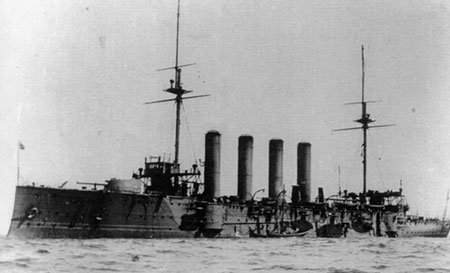 |
 |
HMS Sutlej (left) and HMS Montagu "on the rocks" (right)
Courtesy of Gordon Tufnell
© Copyright Reserved
After three weeks leave he joined a three year old battleship, HMS Montagu, at Portland on the 20 May 1906, and noted in his log that on the 22 May "we dressed ship and fired a salute of 21 guns for the Royal Yacht which had arrived the day before with the Berwick in escort". Shortly afterwards he noted that ""Owing to the accident we were unable to write up our journals between the 25th and the 31st." This "accident" was a major disaster for the Royal Navy which ended the career of the Captain of the Montagu. I shall let Tufnell describe events:
On the 3 September 1906 he "Joined HMS Ocean
at Portland in company with the rest of the Montagu's except those kept
back for the Court Martial." Service in the Channel on the battleship
HMS Ocean was interrupted during its three month refit at Chatham from January to March 1907 by time on HMS Hannibal followed by manoeuvres on the armoured cruiser HMS Hogue.
In January 1908 he was an acting Sub Lieutenant studying Seamnaship,
Navigation, General Subjects, Gunnery and Torpedo at Portsmouth for
nine months before being posted on the 29 September as a Sub Lt Eric
C.E. Tufnell RN to the 12,000 ton twin screwed armoured cruiser, HMS Euryalus. Three days after Christmas a terrible
earthquake at Messina in the toe of Italy killed at least 100,000
in the
city and the surrounding region of Regio Calabria. HMS Euryalus and seven other warships
of the Royal Navy plus merchant ships were among the ships of many
nations which assembled to help rescue survivors. Tufnell received one
of the commemorative medals awarded by the Italian government but when he left Euryalus in May 1909 the assessment of
his CO was damming, "good judgment but takes little interest in his
profession."
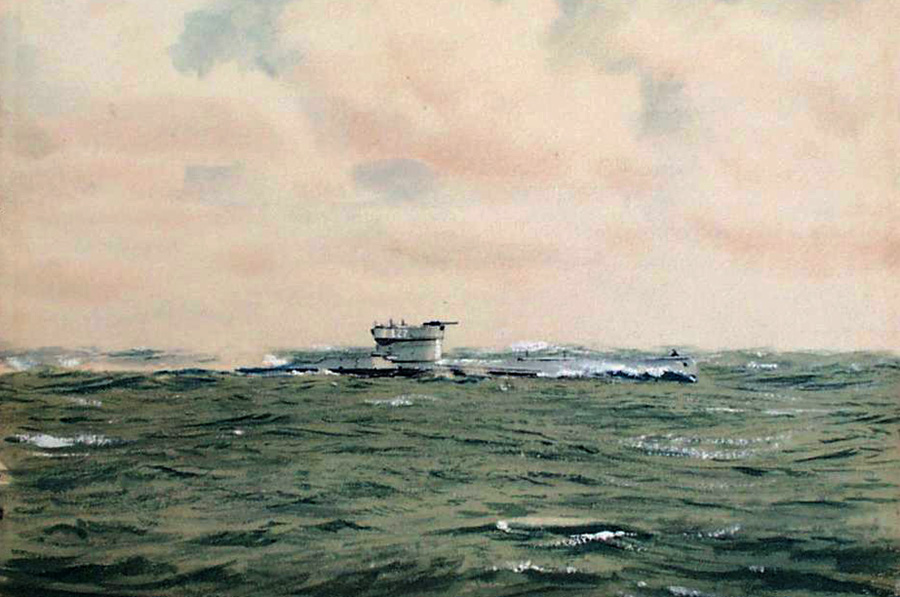
Submarine L27 displaced 1,071 long tons when submerged and was built at Barrow in Furness in 1918
This painting by Eric Tufnell (Accession No. B13/04/68a) is reproduced courtesy of the RN Submarine Museum at Gosport
© Estate of Eric Erskine Campbell Tufnell
This
must have led to the decision to move him from the big ships of the
Royal Navy to service in submarines. This fresh start began with
six months instruction at the submarine depot ship, HMS Mercury, at Portsmouth before he was posted in November 1909 to the submarine, HMS C7, attached to the submarine depot ship, HMS Thames, at Harwich. He served on HMS C7 for nearly three years and was promoted to Lieutenant in October 1910 before being sent to HMS Bonaventure
for two months instruction prior to his first command. In
February 1913 he was given command of the submarine HMS A8 which was
attached to the depot ship HMS Forth.This
may have seemed an inauspicious appointment. Not only was A8 a member
of the first class of British designed submarines but it sank in 1905
while leaving harbour at Plymouth with the hatch open, standard
practice at the time. Fifteen of its crew were lost with only
the four on the conning tower platform being thrown clear and saved. It
was salvaged and brought back into service but could not have been a
popular posting.
In October 1913 he took passage to Gibraltar to take command of B8 working from the submarine depot ship HMS Rapid.
On the 30 October 1914 he married Sigrid Dagmar Wolseley but would have
known that a lieutenant in the navy was in no position to support a
family.
One year later in October 1915 B8 was transferred to HMS Adamant
(1911) as part of the 8th Submarine Flotilla at Mudros for special duties.
Mudros, was a small port on the Greek island of Lemnos, within thirty
miles of the strategically important Dardanelles straits. Allied naval
forces had failed to seize control of the Dardanelles in February and
the Turkish forces contained the bloody land assault at Gallipoli in
August. By October inertia had set in and evacuation of the troops was
being seriously considered and the "special operations" for which B8
was required may have been related to this.
Submarines were small,
cramped and their range was limited and they spent a lot of time
between patrols berthed alongside their depot ships. Eric Tufnell was commissioned to paint all four Royal Navy ships named Adamant, possibly by former officers who served on the submarine depot ship or its submarines.
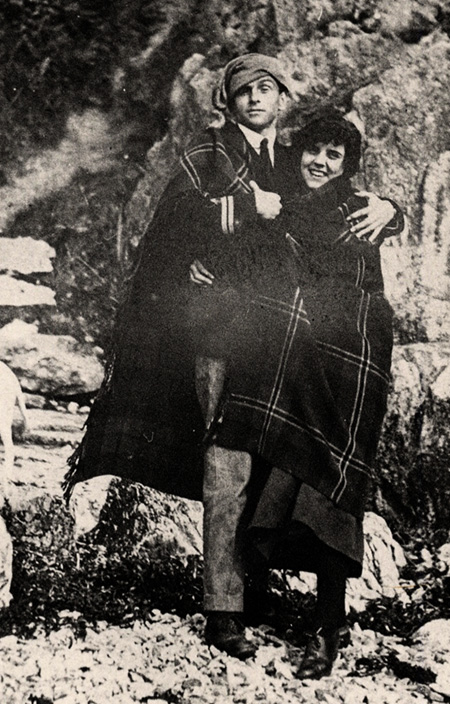 |
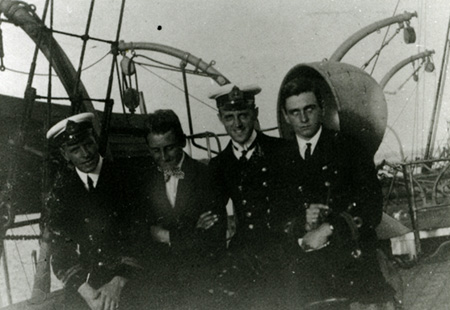 |
It
must have looked as if his career was at an end but once again a change
of direction offered an opportunity for a fresh start. He was posted to HMS Victory
at Portsmouth for "special services in motor launches of hydrophonic
flotilla." Instead of commanding a submarine he would in future be
working to counter the threat of enemy submarines. There were still
some doubt as to his commitment as witnessed by this note on his service record in 1918:
"Not yet settled down to any particular form of work. Appears to prefer
changing from one thing to another too frequently."
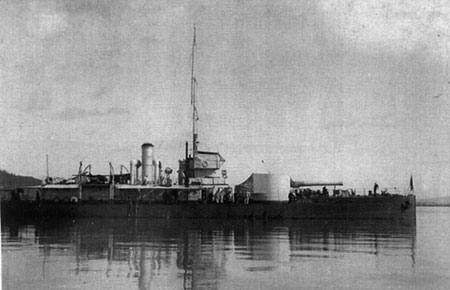
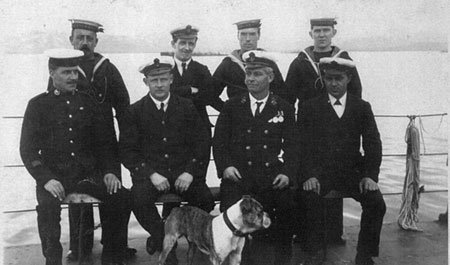
M18 Monitor with 9.2 inch Gun (left) and its Petty Officers - with the ship's mascot
Reproduced courtesy of Gordon Tufnell
© Copyright Reserved
Despite this in June 1918 he was posted to HMS Pekin, the shore base at Grimsby, and in September promoted to Ltd Cdr and given command of the James Dinton,
a new 275 ton Clyde built naval trawler. It was sent to the Black Sea
as part of a fleet of British warships assisting the White Russian army
in their fight against the Red Russians, the Bolsheviks. It was a
strange war in which Red aircraft dropped propaganda leaflets asking
"Why do you fire on us? We are working class men and peasants like you"
and General Borovsky, the White Russian Commander, sent a printed
letter to every sailor who served with the Royal Navy during the
campaign thanking them for their assistance. In December 1918 he was
given
command of M18, a shore bombardment Monitor with a huge 9.2 inch Gun
which served in the Baltic from April to June 1919. Tufnell was
"mentioned in Despatches" (MID) for "services to Russia" in the 12
December issue of the London Gazette and
a year later, to the embarrassment of the Foreign Office, was awarded
the Order of St Stanislaus (2nd Class, with swords) by the defeated
White Russian Army (the announcement had to be censored from the London Gazette).
His ships were getting smaller but his career seemed to be back on
track. And he had a growing family to support, his son Dennis C
Tufnell, always known as "Cuffy" (his father was "Tuffy") was born at Portsmouth on the 17 September 1918.
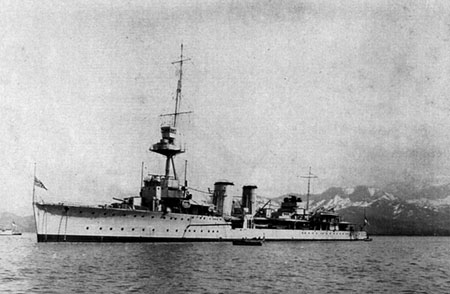
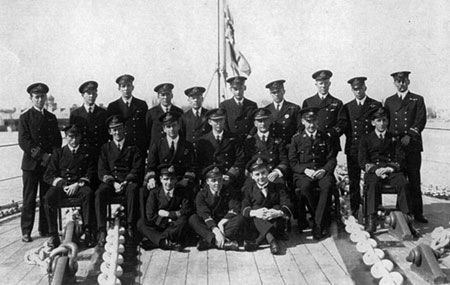
HMS Caradoc at Batum on the Black Sea (left) and its crew (right) in 1920
Lt Cdr Eric C.E. Tufnell RN is third from left seated
Reproduced courtesy of Gordon Tufnell
© Copyright reserved
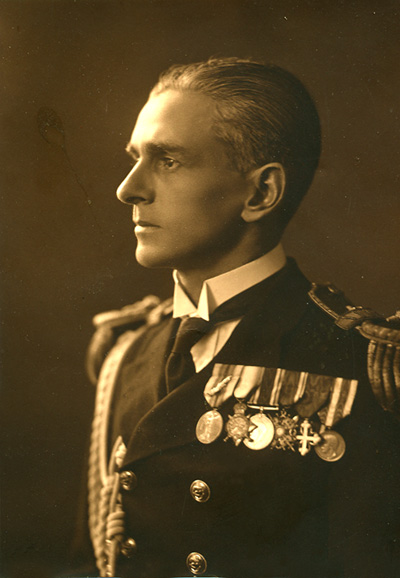 He left M18 in September 1919 to take command of HMS Tuberose, a Flower Class sloop, but confusingly also the name adopted by the Navy for the requisitioned RMS Mauretania when used as a troop carrier. He was not given another post after leaving Tuberose but after six months "unemployment time" at HMS Victory
was put in charge of a draft to Hong Kong. He was on HMS Caradoc at Batum on Black Sea coast of Georgia in 1920 when it was governed by Britain but a telegram from the
Commodore Hong Kong on the 10 September 1920 reported "Returning home,
2.9.20 adverse report from CO Caradoc."
No reason was given but the following action was noted: "Relieved.
Officer informed. He will be placed on half pay" (Caradoc's
log may explain why he received the "adverse report"). He was given
another appointment at Hong Kong but on the 5 March 1922 he arrived in
Britain as a passenger on the PO liner Delta. How would he recover from this latest setback?
He left M18 in September 1919 to take command of HMS Tuberose, a Flower Class sloop, but confusingly also the name adopted by the Navy for the requisitioned RMS Mauretania when used as a troop carrier. He was not given another post after leaving Tuberose but after six months "unemployment time" at HMS Victory
was put in charge of a draft to Hong Kong. He was on HMS Caradoc at Batum on Black Sea coast of Georgia in 1920 when it was governed by Britain but a telegram from the
Commodore Hong Kong on the 10 September 1920 reported "Returning home,
2.9.20 adverse report from CO Caradoc."
No reason was given but the following action was noted: "Relieved.
Officer informed. He will be placed on half pay" (Caradoc's
log may explain why he received the "adverse report"). He was given
another appointment at Hong Kong but on the 5 March 1922 he arrived in
Britain as a passenger on the PO liner Delta. How would he recover from this latest setback?
His career appeared to 'mark time' for the next two years with a six month posting to the depot ship HMS Blenheim at Sheerness (and as acting interpreter in Italian) followed by courses in Signals (HMS Victory) and Gunnery (HMS Excellent) and a posting to the aircraft carrier HMS Argus
while training under the RAF at Lee-on-Solent as an Observer where he
seemed to have done rather well, "has a sound knowledge of observer
subjects."
This
fresh start in a new field as an Observer was interrupted in April 1925
by a year long posting to the British Naval Mission in Greece. By the
mid twenties Britain, France, Italy and the United States were all keen
to increase their influence over minor powers by sending naval missions
to any state which would accept one. These not only increased a
country's prestige but might induce them to buy their warships.
Admiral Tufnell, Naval Adviser to the Greek Government from 1911-3 and
described as the "Father of the Greek Navy" may have helped secure this
appointment where his nephew's social skills might serve his
nation better than his naval skills. It must have been a pleasant
posting and his wife and two small children accompanied him there. His
success is evidenced by the
Greek government making him an Officer of the Order of the Redeemer. He
returned to six months unemployment time at HMS Victory, by now a familiar and no doubt depressing experience.
In December 1926 he was sent as "acting Observer" to HMS Furious
with the Atlantic Fleet and in April 1927 to Farnborough for a course
at the RAF School of Photography: "Result of a photographic course at
RAF School of Photography.
Did not complete course, but did very well." The outcome, a transfer to
the RAF: "Exceptional as Observer for photographic duties. Commenced
duties with RAF, 1 June 1927." He was promoted to Cdr and retired from
the Royal Navy at his own request on the 30 December 1929.
It would appear that the Royal Navy had nothing further to offer him and although his promotion to Commander would give him a higher pension he had a wife and three children to support. His service record ends with a note on the 21 December 1929, "Particulars of service to Colonial Office", but it appears that he did not join the colonial service and returned to Britain with only his small service pension and had to depend on his talent as a marine artist to top up his pension. The Saville Row naval outfitters, Gieves and Hawkes, helped secure naval officers as customers. They commissioned him to paint meticulously accurate water colours of the ships on which they served. He lived near Portsmouth, was active in the local dramatic society - and painted. His charges were modest and his output large.

HMS Vendetta (D69), a V & W Class destroyer, off Garden Island navy base, Sydney
HMS Vendetta was commissioned into the Australian Navy on the 11 October 1933
Reproduced courtesy of Simon Kesley, the photographer and current owner
© Estate of Eric Erskine Campbell Tufnell
When
war seemed imminent in the Autumn of 1938 he offered his services to
the Royal Navy and on the 12 September, two weeks before the Munich
Agreement brought the promise of "peace in our time", was posted to HMS
President in London and sent
on a meteorological training course. In December he was posted as a
Single Observer Forecasting Officer on the staff of the Commander in
Chief, East Indies Station, in Colombo, Ceylon, a solitary job
involving "just me and a barometer". He soon got himself invited to
give a series of fifteen talks for the Colombo Broadcasting Station
about anything to do with ships which were published in 1941 by the
Ceylon Branch of the Navy League as "Spun Yarn". He also met a twenty
two year old nurse, Vera Jane Clark, married to a fellow officer.
Vera had married to escape an unhappy home and despite Tufnell being
thirty years older they fell in love, she became pregnant and returned to England to have their child.
In July 1942 he returned to Britain to take up an appointment as Executive Officer at HMS Minos,
the shore base in Lowestoft responsible for Harbour Defence, small
escort and other craft. The east coast convoys shuttled back and forth
between Rosyth and the Thames estuary and the small boats at Lowestoft
helped repel attacks by marauding E-boats on the defenceless merchant
ships. In March 1943 he was moved to nearby HMS Myladon,
a combined operations based in a disused silk works on the River
Waveney. His next appointment seems more likely to have made good use
of his skill as a communicator. He was posted to HMS President
in London on the Staff of the Chief of Naval Information at the
Ministry of Information with responsibility for publicity, a role which
involved working with the press and radio.
Lt Cdr Angus A. Mackenzie RNR was also stationed at HMS President. Mackenzie was "No 1" to John McBeath on HMS Venomous at Boulogne and Dunkirk and went on to command HMS Vimiera, Liddlesdale and Undaunted.
This could have been where they met which would explain why Mackenzie
commissioned Tufnell to paint four of the five ships on which he had
served, the exception being HMS Vimiera, the loss of which along with most of its crew haunted him for the rest of his life. Tufnell remained at HMS President until he left the Royal Navy for the second time some months after the war ended.



